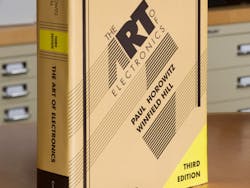This New Edition Is a Must-Have Electronics Classic
Books still matter. Even though the Internet can take care of most of our usual information needs, every now and then we still need more in-depth knowledge. A book can usually take care of that. Most technical publishers have learned to publish quickly before the topic goes out of date, so books are pretty much current.
If you have not bought any books recently, I would like to call your attention to one of my favorite electronics books, The Art of Electronics. A revised 3rd edition was recently published by Cambridge University Press. Written by Paul Horowitz and Winfield Hill, both of Harvard, the book was developed originally for a course for scientists who needed to know about electronics and basic design. It was first published in 1980 and was updated in a 2nd edition in 1989. This latest edition is a major update and worth some consideration.
I first ran across the book in the early 1990s when I was a college professor. The 2nd edition was a great reference for me in teaching electronics fundamentals. The book is practical and minimizes the use of math. It shows all of the most popular circuits and design guidelines for most. The book is a great refresher and enhancer for any college work you may have had.
The first chapter covers electrical principles, passive components, and circuits. This is followed with chapters on bipolars and FETs. Next are chapters on op amps and precision op amp circuits. There is a great chapter on filters of all types highlighted by an understandable introduction to digital signal processing (DSP). The chapter on oscillators covers the basic types as well as crystal oscillators, including TCXO and OCXO. One section covers PLL and DDS synthesizers.
There is an extensive chapter on low-noise design. Not something usually covered elsewhere, but very relevant in today’s designs. This is followed by a comprehensive chapter on voltage regulation and power conversion that includes linear, LDO, all switchers, and inverters. Batteries included. There are three chapters on digital logic, including PLDs and interfacing.
One important updated chapter covers A/D and D/A now with delta-sigma types. Very thorough and practical. PLL design is included. The final chapters cover computer fundamentals and microcontrollers. The 2nd edition used the 68008 as an example, but this newer edition uses a generic embedded controller. A design example is given using C code.
Besides an overall updating with lots of design examples, The Art of Electronics has some additional new features. For example, there are new appendices on transmission lines and impedance matching, television, and SPICE simulation. The high frequency (RF) and measurements chapters from the 2nd edition were omitted because of space, but can still be obtained as e-books from the publisher.
The 2nd edition had a complementary student lab manual and as I understand there is a new version for this latest edition. I have not seen the new lab manual, but assume it continues to offer hands-on lab exercises for classroom use.
If you are looking for a handy and very practical electronics reference book, this is a good one. I think you will enjoy it. Thanks to Horowitz and Hill for updating this classic.
About the Author

Lou Frenzel Blog
Communications Technology
Click here to find more of Lou's articles on Electronic Design.
